Motivational program to improve physical education lessons for sixth-year students of basic education at the Federico Bravo Basurto Educational Unit
Keywords:
Motivational Program, Physical Education Classes, Motivational Strategies, CompetitionAbstract
Objective: To select strategies for the development of a motivational program that improves the teaching-learning process of the subject of physical education.
Methods: For the development of the research, a quantitative and descriptive methodology was used. A survey was applied to university students. In selecting the participants, simple random sampling was used, with 80 students from the Physical Activity Pedagogy degree at the Technical University of Manabí.
Results: The strategies with the highest scores included encouraging teamwork, promoting the importance of effort and personal improvement, enhancing capacities, establishing rules for everyone to participate, recognizing individual progress, developing innovative activities, fostering cognitive and creative styles, explaining the didactic objectives, providing the possibility of choice, incorporating participatory styles, encouraging group interaction, avoiding rivalry, developing self-control, fostering empathy between teacher and student, perceiving the challenges students face, and promoting resilience to overcome problems.
Conclusions: The motivational program must consist of strategies that aim to motivate students and address their psychological needs in four areas: competence, autonomy, relationships between students, and the teacher-student relationship.
Downloads
References
Acero, J. M. A., Coca, M. M., & Coca, D. M. (2020). Motivación de alumnos de Educación Secundaria y Bachillerato hacia el uso de recursos digitales durante la crisis del Covid-19. Revista de Estilos de Aprendizaje, 13, 68-81.
Aristizabal-Almanza, J. L., Ramos-Monobe, A., & Chirino-Barceló, V. (2018). Aprendizaje activo para el desarrollo de la psicomotricidady el trabajo en equipo. Revista Electrónica Educare, 22(1), 319-344. http://dx.doi.org/10.15359/ree.22-1.16
Calvo, C. O., Pérez-Tejero, J., & López, J. C. (2015). Propuesta de un programa de intervención educativa para facilitar la inclusión de alumnos con discapacidad en educación física. Retos, 27, 140-145.
Crespo, L. V., Pernas, R. G., & Bóo, Y. T. (2016). Ocio y usos del tiempo libre en adolescentes de 12 a 16 años en España. Educação e Pesquisa, 42(4), 987-999.
ENSANUT (2018). Encuesta Nacional de Salud y Nutrición. Obtenido en: https://www.ecuadorencifras.gob.ec/salud-salud-reproductiva-y-nutricion/#:~:text=La%20Encuesta%20Nacional%20de%20Salud,de%20salud%20de%20la%20poblaci%C3%B3n
Gervilla-Navarro, M. D. C., & Morón-Cívico, B. (2020). Percepciones del estudiantado universitario en relación al trabajo en equipo. Archivos de Medicina Universitaria, 2(1), 120-125.
González-Cutre, D. (2017). Estrategias didácticas y motivacionales en las clases de educación física desde la teoría de la autodeterminación. E-Motion, 8, 44-62.
Gutiérrez, J. C. (2018). Impacto de la interacción en grupo en la producción de la lengua del álgebra en clase de matemáticas. Avances de Investigación en Educación Matemática, 14, 31-47.
Hidalgo Fuentes, S., Sospedra-Baeza, M. J., & Martínez-Álvarez, I. (2018). Análisis de las inteligencias múltiples y creatividad en universitarios. Ciencias Psicológicas, 12(2), 271-280.
Lamana-Selva, M. T., & Peña, C. D. L. (2018). Rendimiento académico en matemáticas. Relación con creatividad y estilos de afrontamiento. Revista Mexicana de Investigación Educativa, 23(79), 1075-1092.
Martínez Martínez, F. D., & González Hernández, J. (2017). Autoconcepto, práctica de actividad física y respuesta social en adolescentes. Relaciones con el rendimiento académico. Revista Iberoamericana De Educación, 73(1), 87-108. https://doi.org/10.35362/rie731127
Moreto, G., Blasco, P. G., & Piñero, A. (2018). Reflexiones sobre la deshumanización de la educación médica: empatía, emociones y posibles recursos pedagógicos para la educación afectiva del estudiante de medicina. Educación Médica, 19(3), 172-177.
Pilataxi Acero, S. R. (2021). Niveles de creatividad y actividades lúdicas recreativas en la clase de educación física modalidad virtual en escolares [Bachelor's thesis, Universidad Técnica de Ambato-Facultad de Ciencias Humanas y de la Educación-Carrera de Pedagogía de la Actividad Física y Deporte].
Rello, C. F., Puerta, I. G., & Tejero-González, C. M. (2020). Cambiando las actitudes hacia la discapacidad: diseño de un programa de sensibilización en Educación Física. Retos, 37, 713-721.
Rodríguez, A. C., Valenzuela, A. V., & Martínez, B. J. S. A. (2016). La importancia de la educación física en el sistema educativo. EmásF, 43, 83-96.
Rodríguez, Á., Páez, R., Paguay, F y Rodríguez, J. (2018). El profesorado de educación física y la promoción de salud en los centros educativos. Revista Arrancada, 18(34), 215- 235.
Sánchez-Baño, M., Visiedo, A., & de Baranda, P. S. (2018). Cuantificación de los niveles de actividad física a través de podómetros en las clases de Educación Física: Un estudio piloto. SPORT TK-Revista Euroamericana de Ciencias del Deporte, 7(1), 19-26.
Tapia López, A. (2019). Diferencias en los niveles de actividad física, grado de adherencia a la dieta mediterránea y autoconcepto físico en adolescentes en función del sexo. Retos, 36(36), 185-192.
Valero-Valenzuela, A., Merino-Barrero, J. A., Manzano-Sánchez, D., Belando-Pedreño, N., Fernández-Merlos, J. D., & Moreno-Murcia, J. A. (2020). Influencia del estilo docente en la motivación y estilo de vida de adolescentes en educación física. Universitas Psychologica, 19, 1-11.
Zamarripa, J., Castillo, I., Tomás, I., Tristán, J., & Álvarez, O. (2016). El papel del profesor en la motivación y la salud mental de los estudiantes de educación física. Salud Mental, 39(4), 221-227.
Zueck, M. D. C., García, A. A. R., Villalobos, J. M. R., & Gutiérrez, H. E. I. (2020). Satisfacción en las clases de Educación Física y la intencionalidad de ser activo en niños del nivel de primaria. Retos, 37, 33-40.
Downloads
Published
How to Cite
Issue
Section
License
Copyright and Licensing
For all articles published in Atena Journals, copyright is retained by the authors. Articles are licensed under an open access Creative Commons CC BY 4.0 license, meaning that anyone may download and read the paper for free. In addition, the article may be reused and quoted provided that the original published version is cited. These conditions allow for maximum use and exposure of the work, while ensuring that the authors receive proper credit.
Reproducing Published Material from other Publishers
It is absolutely essential that authors obtain permission to reproduce any published material (figures, schemes, tables or any extract of a text) which does not fall into the public domain, or for which they do not hold the copyright. Permission should be requested by the authors from the copyrightholder (usually the Publisher, please refer to the imprint of the individual publications to identify the copyrightholder).
Permission is required for:
- Your own works published by other Publishers and for which you did not retain copyright.
- Substantial extracts from anyones' works or a series of works.
- Use of Tables, Graphs, Charts, Schemes and Artworks if they are unaltered or slightly modified.
- Photographs for which you do not hold copyright.
Permission is not required for:
- Reconstruction of your own table with data already published elsewhere. Please notice that in this case you must cite the source of the data in the form of either "Data from..." or "Adapted from...".
- Reasonably short quotes are considered fair use and therefore do not require permission.
- Graphs, Charts, Schemes and Artworks that are completely redrawn by the authors and significantly changed beyond recognition do not require permission.
Obtaining Permission
In order to avoid unnecessary delays in the publication process, you should start obtaining permissions as early as possible. If in any doubt about the copyright, apply for permission. Atena Journals cannot publish material from other publications without permission.
The copyright holder may give you instructions on the form of acknowledgement to be followed; otherwise follow the style: "Reproduced with permission from [author], [book/journal title]; published by [publisher], [year].' at the end of the caption of the Table, Figure or Scheme.














